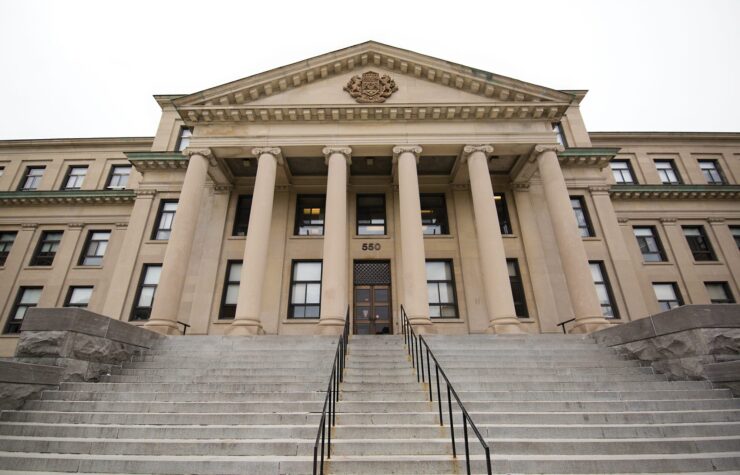Violence and harassment faced by students making attending in-person courses difficult
Twenty days after truckers first arrived in Ottawa as part of the “Freedom Convoy” protests, reports show that approximately 400 trucks still occupy the downtown area. For local residents — including many U of O students — the occupation has spelled not only disruption, but harassment.
The Lowertown, Centretown and Sandy Hill neighbourhoods are home to many students who have had to endure unfortunate consequences to these protests.
Caught in the crossfire
The protest began Friday, Jan. 28, when the convoy and its supporters made their way to Ottawa to demonstrate against vaccine mandates. By 2:30 p.m. on Jan. 29, the downtown area was declared to be gridlocked.
Despite ongoing concerns from faculty and student associations that these circumstances are too dangerous for students, the U of O decided to go ahead with their return to in-person learning on Jan. 31. With police moving in on protesters, it reversed that decision on Feb.16.
The Fulcrum spoke with second-year health sciences student Ella Van Horne after the first weekend of protests.
“I also live across from a hotel where a lot of the protesters are staying. So they were arriving Thursday [Jan. 27] and Friday [Jan.28] and already parking and blocking the streets a bit,” she said in the interview.
Van Horne explained that the noise comes and goes, since she is not exactly at the centre of the protests. Horns honking and protestors yelling have been common complaints from downtown residents since the protestors arrived in the city.
“I will be in the middle of a class or a test, and suddenly there’s a bunch of noise outside, and I can’t concentrate or people can’t hear me properly. In terms of classes and stuff it’s been really disturbing,” she explained.
Second-year sociology and anthropology student Vern Ivie spoke to the Fulcrum after the second week of protests. Not only has their academic life been disrupted by bus route detours, but on Feb. 5 their commute was disrupted by a run-in with aggressive protestors.
“I was walking downtown last Saturday, and two protesters were yelling at me to take my mask off as they’re walking towards me. And when they walked past I said ‘leave me alone,’ and then one of them threw a frozen water bottle at me,” they said.
“I wasn’t hurt or anything, but I feel like anybody who’s still pretending that these people are peaceful are clearly just ignoring the countless harassment and assault and property damages that [have been reported]. It’s leaving a huge toll on people physically and mentally.”
This has now affected the return to campus for Ivie, as they fear going back to campus for their in-person lectures.
“I had an in-person course that I was attending, but I’ve been watching it over Zoom because I don’t want to risk going downtown again. I just don’t want to deal with encountering these people. Just going downtown and seeing all of this is so troubling. It’s definitely impacted my mental health. I hate seeing all these people downtown pretending that they care about freedom when they’re taking away the freedoms of the people that actually live here,” they said.
Van Horne argued that this reluctance is widespread. She attended an in-person class on Monday, Jan. 31. She said only a third of her class attended, despite the professor not recording the lecture or sharing PowerPoint slides.
Later in the week, to alleviate concerns around safety, Van Horne and her roommate asked their boyfriends to come stay with them at their apartment. On his way to the apartment one night, her boyfriend was approached and verbally harassed by several protestors.
Since this incident, and hearing of other encounters her friends have had with the protesters, she is in a similar position as Ivie.
“Yeah, after that we’ve all been kind of scared. We’re not leaving the apartment, just in case. It’s not too extreme here, but we don’t want to take any chances,” Van Horne said.
Students living on campus have not been insulated against troubling encounters, either.
In a recent interview with the Fulcrum, students living in the University’s LeBlanc residence expressed concerns after a member of the convoy broke into the residence building on Jan. 30. The University denied that it was a member of the protests, but student pictures show he was carrying a Canadian flag.
In addition to direct interactions with protestors, many U of O students feel threatened by the symbols of hate and racist paraphernalia that have been associated with the protest.
On Feb. 4, a week into the demonstrations, the University of Ottawa acknowledged in an email the distress that the “hatred, racism, and homophobia downtown” could cause for the students. They recommended students reach out to mental health and support services on campus.
At the time, however, the University did not deem the situation worth returning to a virtual learning environment.






